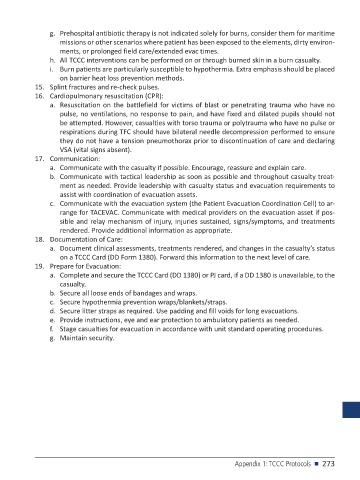Page 275 - PJ MED OPS Handbook 8th Ed
P. 275
g. Prehospital antibiotic therapy is not indicated solely for burns, consider them for maritime
missions or other scenarios where patient has been exposed to the elements, dirty environ-
ments, or prolonged field care/extended evac times.
h. All TCCC interventions can be performed on or through burned skin in a burn casualty.
i. Burn patients are particularly susceptible to hypothermia. Extra emphasis should be placed
on barrier heat loss prevention methods.
15. Splint fractures and re-check pulses.
16. Cardiopulmonary resuscitation (CPR):
a. Resuscitation on the battlefield for victims of blast or penetrating trauma who have no
pulse, no ventilations, no response to pain, and have fixed and dilated pupils should not
be attempted. However, casualties with torso trauma or polytrauma who have no pulse or
respirations during TFC should have bilateral needle decompression performed to ensure
they do not have a tension pneumothorax prior to discontinuation of care and declaring
VSA (vital signs absent).
17. Communication:
a. Communicate with the casualty if possible. Encourage, reassure and explain care.
b. Communicate with tactical leadership as soon as possible and throughout casualty treat-
ment as needed. Provide leadership with casualty status and evacuation requirements to
assist with coordination of evacuation assets.
c. Communicate with the evacuation system (the Patient Evacuation Coordination Cell) to ar-
range for TACEVAC. Communicate with medical providers on the evacuation asset if pos-
sible and relay mechanism of injury, injuries sustained, signs/symptoms, and treatments
rendered. Provide additional information as appropriate.
18. Documentation of Care:
a. Document clinical assessments, treatments rendered, and changes in the casualty’s status
on a TCCC Card (DD Form 1380). Forward this information to the next level of care.
19. Prepare for Evacuation:
a. Complete and secure the TCCC Card (DD 1380) or PJ card, if a DD 1380 is unavailable, to the
casualty.
b. Secure all loose ends of bandages and wraps.
c. Secure hypothermia prevention wraps/blankets/straps.
d. Secure litter straps as required. Use padding and fill voids for long evacuations.
e. Provide instructions, eye and ear protection to ambulatory patients as needed.
f. Stage casualties for evacuation in accordance with unit standard operating procedures.
g. Maintain security.
Appendix 1: TCCC Protocols n 273

